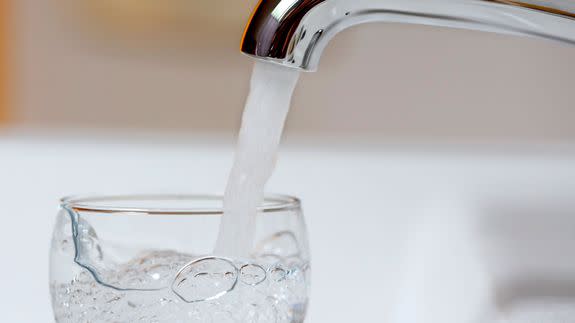'Erin Brockovich' chemical found in more than 200 million Americans' tap water

Tap water supplies for roughly 218 million Americans nationwide were found to have chromium-6, a carcinogenic chemical, at levels above California's public health goals, a new study found.
The Environmental Working Group (EWG), a nonprofit research and advocacy organization, analyzed more than 60,000 samples of drinking water taken from taps across the United States. Thousands of local water utilities gathered the samples from 2013 to 2015 as part of a U.S. Environmental Protection Agency (EPA) program.
SEE ALSO: Coca-Cola says it 'replenished' all the water it used to make its soft drinks
Over 75 percent of the water samples contained levels of chromium-6 above 0.02 parts per billion. That’s the threshold at or below which California state scientists say chromium-6 would pose a "negligible" cancer risk over a lifetime of consumption.

Image: environmental working group
"Chromium-6 is so widespread, in terms of its distribution across drinking water sources," David Andrews, a senior scientist at EWG, told Mashable.
"I should be shocked by the findings of EWG's report, but I am not," Erin Brockovich, the crusading environmental legal clerk and inspiration for the 2000 film starring Julia Roberts, said in a statement Tuesday.
Brockovich brought chromium-6 into the national spotlight in the 1990s after fighting a California power company that allegedly leaked the chemical into tap water supplies in Hinkley, California, sickening residents. The case was settled for $333 million.
She said that EWG's findings were "nothing short of an outrage."

Image: AP Photo/Las Vegas Sun, Lori Cain
But does the report mean that over two-thirds of the U.S. population could develop cancer from their drinking water?
Not exactly.
Chromium-6, or hexavalent chromium, naturally appears in some minerals, but it can also sneak into drinking water supplies through industrial pollution. The chemical is used to manufacture stainless steel, textiles, for anticorrosion coatings and in leather tanning.
California's public health goal of 0.02 parts per billion effectively means that if a million people drank water with that level of chromium-6 every day for 70 years, one additional case of cancer would occur, according to the California Office of Environmental Health Hazard Assessment (OEHHA), which set the state's health target.
Even so, "Water containing levels that exceed the public health goal can still be considered acceptable for consumption," Sam Delson, the office's deputy director for external and legislative affairs, said in an email.
"The public health goal is not a boundary between a safe and dangerous level of chromium-6, and it is not considered the highest level that is safe to drink," he added.
California established a public health goal in response to a handful of studies that showed chromium-6 can cause cancer in animals. A 2008 study by the National Toxicology Program, for instance, found that drinking water with chromium-6 caused cancer in lab rats and mice.
Scientists at OEHHA extrapolated from that research that ingesting even tiny amounts of chromium-6 could cause cancer in people.
In 2011, the office established the "very conservative" public health target of 0.02 parts per billion, which factored in the increased susceptibility of young children and other sensitive groups, Delson said.
California's health target was designed to help inform California legislators as they crafted the nation's only state-specific legal limits for chromium-6 in drinking water.
The Golden State — the world's sixth largest economy — struck out on its own because a federal limit for chromium-6 does not exist. The EPA instead has a 25-year-old drinking water standard of 100 parts per billion for total chromium, which includes chromium-6 as well as chromium-3.
"At a national level, we're still operating under an outdated standard that doesn't even address this particular chemical," Bill Walker, EWG's vice president, told Mashable.
"EPA's drinking water regulations lag behind science," he said.

Image: Environmental Working group
California's own state limit for chromium-6 is significantly higher than the public health target of 0.02 parts per billion. In 2014, legislators in that state adopted a "maximum contaminant level" of 10 parts per billion, a level that appeased the state's chemical companies but disappointed environmental groups, including EWG.
"We don't believe that it's adequately protective of public health," Walker said of the 10-parts-per-billion state limit.
Still, the California standard for chromium-6 is ten times lower than what the federal standard is for both chromium-6 and chromium-3.
Delson said that while the more conservative 0.02 parts per billion public health goal is based solely on health protection, the maximum contamination level must be set at a level that is technically and economically feasible for the state's utilities to meet.
EPA standards may lie ahead
The EPA, for its part, is working to develop a risk assessment of chromium-6, which will include a comprehensive evaluation of the health effects associated with the chemical. The agency said it expects to release its draft risk assessment for public comment in 2017.
The EPA ordered nearly 5,000 public water systems to collect water samples — the ones that EWG analyzed — to help paint a nationally representative picture of the occurrence of chromium-6 and total chromium in the nation's drinking water supplies.
Regulators found that less than 2 percent of those roughly 5,000 systems had levels of chromium-6 exceeding California's standard of 10 parts per billion, the EPA told Mashable. Only one system exceeded the EPA's standard for total chromium.
"Ensuring safe drinking water for all Americans is a top priority for EPA," the agency said in an email.

